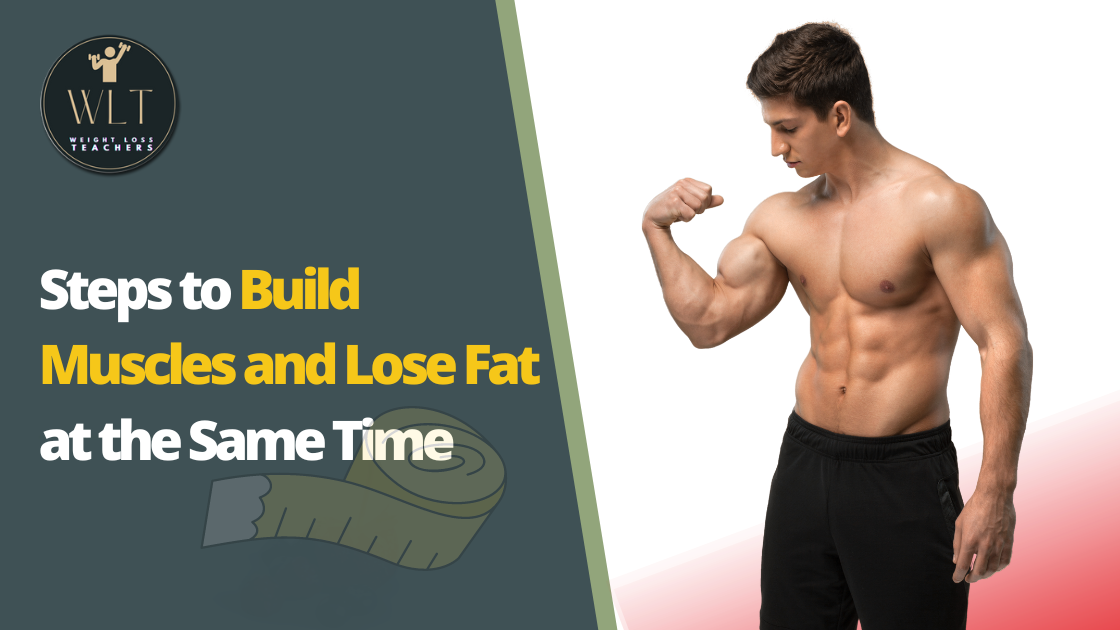
Steps to Build Muscles and Lose Fat at the Same Time
Understanding the science behind body recomposition and implementing practical strategies can make all the difference. Explore the steps to optimize your workout and nutrition plan to effectively build muscles and lose fat at the same time. Here are some expert tips to get you started on your fitness journey
One of the most significant aspects of body composition is reducing body fat percentage. If you find yourself with a body fat percentage of 30% or higher and are aiming to reach a healthier 10% range, this comprehensive guide is tailored to help you achieve your goal.
Before diving into the specifics of fat loss strategies, it’s essential to understand the basics of body fat percentage, its significance, and the factors that contribute to high body fat levels.
Table of Contents
Understanding Body Fat Percentage: A Key to Health and Fitness

In the quest for a healthier and fitter body, understanding body fat percentage is paramount. It’s a crucial metric that goes beyond the numbers on a scale and provides a more accurate assessment of overall health and fitness. In this comprehensive guide, we will delve into the significance of body fat percentage and explore its various categories, all while emphasizing the importance of maintaining a healthy balance.
The Basics of Body Fat Percentage
Body fat percentage, simply put, is the proportion of your total body weight that consists of fat tissue. This metric is essential because it offers a more nuanced view of your physical well-being compared to relying solely on body weight. While some amount of body fat is necessary for critical bodily functions, having an excess can lead to a range of health problems, including heart disease, diabetes, and obesity-related conditions.
To better understand body fat percentage, let’s break it down into three primary categories:
Essential Fat
Essential fat is the minimum amount of fat needed for the body to function optimally. It is indispensable for vital processes like regulating body temperature, cushioning organs, and hormone production. Essential fat levels are slightly higher in women compared to men, primarily due to the demands of female reproductive physiology.
Storage Fat
Storage fat, as the name suggests, is the extra fat that your body stores in adipose tissue throughout various areas, including subcutaneous fat beneath the skin and visceral fat around your organs. It’s this type of fat that becomes problematic when accumulated in excess, leading to obesity and its associated health risks.
Lean Body Mass

Your lean body mass encompasses everything that isn’t fat, such as muscle, bone, organs, and other non-fat components. This is an essential part of the equation because, during weight management and fitness endeavors, it’s vital to preserve or increase lean body mass while reducing fat mass.
Determining a Healthy Body Fat Percentage
The ideal body fat percentage varies from person to person, influenced by factors such as age, gender, and individual goals. For men, a body fat percentage in the range of approximately 10-20% is generally considered healthy. For women, the healthy range typically falls between 18-28%. However, these ranges can shift slightly depending on specific fitness and athletic goals.
Here’s a table outlining healthy body fat percentage ranges for different demographics:
| Demographic | Healthy Body Fat Percentage |
|---|---|
| Adult Men | 6% – 24% |
| Adult Women | 14% – 31% |
| Athletic Men | 6% – 13% |
| Athletic Women | 14% – 20% |
| Men (Aged 20-39) | 8% – 19% |
| Women (Aged 20-39) | 21% – 33% |
| Men (Aged 40-59) | 11% – 21% |
| Women (Aged 40-59) | 23% – 34% |
| Men (Aged 60-79) | 13% – 24% |
| Women (Aged 60-79) |
It’s crucial to note that these ranges serve as guidelines, and what’s most important is achieving a body fat percentage that aligns with your personal health and fitness objectives. For some individuals, especially athletes or bodybuilders, temporarily dipping below these ranges may be necessary for competition purposes. However, maintaining extremely low body fat percentages long-term can be detrimental to overall health.
Factors Contributing to High Body Fat Percentage: Understanding the Culprits

High body fat percentage can be a result of various factors, and understanding these contributors is essential when embarking on a journey to reduce it. In this comprehensive exploration, we’ll delve into the root causes of elevated body fat percentages, shedding light on the impact of diet, lifestyle, genetics, hormones, stress, sleep, and medical conditions.
Poor Diet
Dietary habits play a pivotal role in determining body fat percentages. Consuming excessive calories, particularly from unhealthy sources, can lead to weight gain and increased body fat. Here are some dietary factors contributing to high body fat percentages:
- Excessive Caloric Intake: Regularly consuming more calories than your body needs for energy can lead to an energy surplus, which is stored as fat. This often results from overeating, consuming large portion sizes, or indulging in high-calorie, nutrient-poor foods.
- Sugary Drinks: Sugar-sweetened beverages like soda, energy drinks, and fruit juices are loaded with empty calories. These beverages can lead to weight gain when consumed in excess.
- Processed Foods: Highly processed foods often contain added sugars, unhealthy fats, and excessive sodium. These calorie-dense, nutrient-poor options can contribute to weight gain and increased body fat.
- High-Fat Snacks: Snacking on foods high in unhealthy fats, such as potato chips, fried snacks, and baked goods, can add extra calories and contribute to fat accumulation.
- Inadequate Nutrient Intake: Poor dietary choices can also lead to nutrient deficiencies, which can impact metabolism and contribute to fat storage.
To reduce body fat percentage, it’s crucial to adopt a balanced diet that focuses on nutrient-dense foods while moderating calorie intake.
Sedentary Lifestyle
A sedentary lifestyle, characterized by prolonged periods of sitting or low physical activity levels, can significantly contribute to high body fat percentages. Here’s how it happens:
- Slowed Metabolism: Remaining sedentary for extended periods can lead to a slower metabolism, reducing the number of calories your body burns at rest.
- Reduced Caloric Expenditure: Engaging in minimal physical activity means fewer calories burned throughout the day, making it easier for excess calories to be stored as fat.
- Muscle Atrophy: A lack of physical activity can lead to muscle loss, as muscles require regular use to stay strong and metabolically active. Muscle loss can further decrease the body’s ability to burn calories.
To counteract the sedentary lifestyle factor, it’s essential to incorporate regular physical activity into your daily routine. This can include activities such as walking, cycling, swimming, and strength training exercises.
Genetics
Genetics also play a role in determining body fat percentage. Each individual’s genetic makeup can influence factors like metabolism, fat storage patterns, and overall body composition. Some people may have a genetic predisposition to store fat more readily than others, making it more challenging to maintain lower body fat percentages.
While genetics can be a contributing factor, it’s important to remember that lifestyle choices, including diet and exercise, can have a significant impact on body fat levels, even for individuals with a genetic predisposition to higher body fat.
Hormonal Imbalances
Hormonal changes in the body can affect weight and body fat distribution. Several factors related to hormones can contribute to high body fat percentages:
- Menopause: Women going through menopause often experience hormonal changes that can lead to weight gain, particularly in the abdominal area. This shift is partly attributed to changes in estrogen levels.
- Thyroid Disorders: Conditions such as hypothyroidism, where the thyroid gland doesn’t produce enough thyroid hormones, can slow down metabolism and result in weight gain and increased body fat.
- Polycystic Ovary Syndrome (PCOS): PCOS is a hormonal disorder that can lead to insulin resistance and weight gain, often concentrated around the abdomen.
- Cortisol: Chronic stress can lead to increased cortisol levels, a stress hormone that can contribute to fat storage, particularly in the abdominal area.
Balancing hormones through lifestyle modifications, stress reduction techniques, and, in some cases, medical interventions can help mitigate the impact of hormonal imbalances on body fat.
Stress

Chronic stress can have a profound impact on body fat percentage. When individuals experience stress, their bodies release cortisol, a hormone that can lead to weight gain and fat accumulation. Here’s how stress contributes to elevated body fat percentages:
- Increased Appetite: Stress can trigger emotional eating, causing individuals to seek comfort in calorie-dense, often unhealthy foods.
- Abdominal Fat Storage: Cortisol release during periods of stress has been associated with increased fat storage in the abdominal area, which can be particularly harmful to health.
- Disrupted Sleep: Stress can lead to poor sleep patterns, which, in turn, disrupt hormone regulation and can contribute to weight gain and increased fat storage.
To combat the effects of stress on body fat percentage, incorporating stress management techniques such as meditation, deep breathing exercises, yoga, and mindfulness practices can be beneficial.
Here’s a table outlining a diet plan to help manage stress and support weight loss:
| Meal | Food Options |
|---|---|
| Breakfast | Oatmeal with fresh berries, Greek yogurt with honey, Scrambled eggs with spinach and avocado |
| Snack | Almonds, Carrot sticks with hummus, Apple slices with peanut butter |
| Lunch | Grilled chicken salad with mixed greens, Quinoa bowl with roasted vegetables, Turkey and avocado wrap |
| Snack | Greek yogurt with chia seeds, Mixed nuts, Cottage cheese with cherry tomatoes |
| Dinner | Baked salmon with steamed broccoli, Stir-fried tofu with mixed vegetables, Grilled chicken with quinoa |
| Snack | Dark chocolate, Berries with a dollop of whipped cream, A small bowl of mixed fruit |
This diet plan includes nutrient-dense foods that can help manage stress and support weight loss. Remember to stay hydrated and get regular exercise to complement your diet. If you have any dietary restrictions or health concerns, it’s always a good idea to consult with a healthcare professional or a registered dietitian.
Lack of Sleep

Adequate sleep is crucial for overall health and can significantly impact body fat percentage. Poor sleep patterns can disrupt hormone regulation and lead to weight gain and increased fat storage. Here’s how:
- Hormone Disruption: Sleep deprivation can disrupt hormones that regulate hunger (ghrelin) and fullness (leptin), leading to increased appetite and overeating.
- Increased Cravings: Lack of sleep has been linked to increased cravings for high-calorie, sugary, and high-fat foods.
- Reduced Physical Activity: Fatigue from lack of sleep can lead to decreased physical activity and exercise, making it more challenging to burn calories.
To improve sleep quality and support fat loss efforts, prioritize consistent sleep patterns, create a conducive sleep environment, and establish a relaxing bedtime routine.
Medical Conditions
Certain medical conditions can contribute to weight gain and higher body fat percentages. These conditions can vary widely but often involve disruptions in metabolism or hormonal balance. Two common medical conditions that can contribute to elevated body fat percentages are:
- Hypothyroidism: In hypothyroidism, the thyroid gland doesn’t produce enough thyroid hormones, leading to a slowed metabolism and potential weight gain.
- Polycystic Ovary Syndrome (PCOS): PCOS can lead to insulin resistance, making it easier to gain weight, especially around the abdomen.
- Cushing’s Syndrome: This rare condition involves the overproduction of cortisol, resulting in fat accumulation, particularly in the face, upper back, and abdomen.
Individuals with these or other medical conditions should work closely with healthcare professionals to manage their conditions and develop tailored strategies for weight management and fat loss.
Note: There might be affiliate links mentioned here. We may receive a commission if you purchase a product through an affiliate link. There is no additional charge for you. Please do your own research before making any online purchases.
The Journey from 30% to 10% Body Fat

If you find yourself with a body fat percentage of 30% or higher and are aiming to reach the healthier 10% range, it’s essential to approach this transformation with patience, dedication, and a well-informed strategy.
To embark on this journey successfully, consider the following steps:
Set Realistic Goals
Before diving headfirst into your fat loss journey, it’s crucial to establish clear and attainable objectives. Understand that reducing your body fat percentage from 30% to 10% is a significant transformation that requires time and commitment. Consulting with a healthcare professional or certified fitness expert can help you set realistic goals tailored to your unique circumstances.
Create a Calorie Deficit
The foundation of fat loss is to create a calorie deficit, which means expending more calories than you consume. To achieve this, follow these steps:
- Calculate Your Basal Metabolic Rate (BMR): Your BMR represents the number of calories your body needs to maintain basic functions at rest. Numerous online calculators can help you estimate your BMR accurately.
- Determine Your Daily Caloric Intake: Once you have your BMR, calculate your daily caloric intake by adjusting your BMR based on your activity level. You can use an activity factor, such as 1.2 for sedentary or 1.55 for moderately active individuals.
- Create a Calorie Deficit: To initiate fat loss, aim for a daily calorie deficit of 500 to 1,000 calories. This deficit can lead to a safe and sustainable weight loss of approximately 1 to 2 pounds per week.
- Monitor Your Intake: Keep a food diary or use a mobile app to track your daily calorie consumption. Pay close attention to portion sizes and prioritize healthier food choices.
Adopt a Balanced Diet
Nutrition plays a pivotal role in sustainable fat loss. Embrace the following dietary principles to support your journey:
- Include Lean Proteins: Protein is vital for maintaining muscle mass and promoting feelings of fullness. Incorporate sources such as lean meats, poultry, fish, tofu, beans, and legumes into your diet.
- Choose Complex Carbohydrates: Opt for whole grains, fruits, vegetables, and legumes as your primary sources of carbohydrates. These provide sustained energy and essential nutrients.
- Healthy Fats: While it’s essential to reduce overall fat intake to create a calorie deficit, include sources of healthy fats like avocados, nuts, seeds, and olive oil in moderation. These fats support overall health and can aid in fat loss.
- Portion Control: Be mindful of portion sizes to avoid overeating. Consider eating smaller, more frequent meals to manage hunger effectively.
- Stay Hydrated: Proper hydration is essential for metabolism and overall health. Drink plenty of water throughout the day.
- Limit Sugary and Processed Foods: Minimize your consumption of sugary beverages, sweets, and processed foods, as they tend to be calorie-dense and lack essential nutrients.
- Track Macros: Some individuals find it helpful to track macronutrients (protein, carbohydrates, and fats) to gain better control over their calorie intake. There are mobile apps and online tools that can assist with this.
Prioritize Strength Training:
Incorporating strength training into your fitness regimen is critical for preserving and building lean muscle mass. Muscle tissue burns more calories at rest than fat tissue, which contributes to an increased metabolic rate. Here’s how to get started:
- Seek Professional Guidance: If you’re new to strength training, consider working with a certified personal trainer to develop a customized workout plan that aligns with your goals.
- Lift Weights: Concentrate on compound exercises that engage multiple muscle groups simultaneously. Examples include squats, deadlifts, bench presses, and rows.
- Implement Progressive Overload: Continually challenge your muscles by increasing the weights or resistance you use over time. This practice promotes muscle growth and strength gains.
- Include Cardiovascular Exercise: While strength training is vital, don’t neglect cardiovascular exercises like running, cycling, or swimming. These activities help burn additional calories and enhance cardiovascular health.
- Maintain Consistency: Aim to engage in strength training at least 2-3 times per week, ensuring that you target all major muscle groups.
Engage in Regular Cardiovascular Exercise
Cardiovascular exercise complements strength training by burning calories and improving overall fitness. To make the most of your cardio workouts, follow these guidelines:
- Choose Activities You Enjoy: Select cardio exercises that you genuinely enjoy, whether it’s running, cycling, dancing, or swimming. Enjoyment will help maintain motivation.
- Gradually Increase Intensity: Start at a comfortable level and progressively intensify your cardio workouts over time, both in terms of duration and intensity.
- Mix It Up: Incorporate a combination of steady-state cardio (e.g., jogging) and high-intensity interval training (HIIT) to add variety and optimize results.
- Monitor Progress: Keep track of your cardiovascular workouts to observe improvements in your fitness level, which can be a motivating factor and help you set new goals.
- Maintain Consistency: Strive for at least 150 minutes of moderate-intensity aerobic activity or 75 minutes of vigorous-intensity aerobic activity per week, as recommended by the American Heart Association.
Prioritize Sleep and Manage Stress
Adequate sleep and effective stress management are pivotal factors in weight management and fat loss:
- Prioritize Sleep: Aim for 7-9 hours of quality sleep each night. Inadequate sleep can disrupt hormones related to hunger and appetite regulation.
- Manage Stress: Incorporate stress-reduction techniques such as meditation, deep breathing exercises, yoga, or mindfulness practices into your daily routine. Managing stress can mitigate emotional eating and help control cortisol levels, a stress hormone associated with fat storage.
Stay Hydrated
Proper hydration is essential for overall health and can support your fat loss efforts. Drinking enough water can help control appetite and prevent the confusion between thirst and hunger. Aim to consume at least eight 8-ounce glasses (approximately 2 liters) of water daily, and more if you engage in physical activity.
Monitor Your Progress
To stay motivated and track your fat loss journey effectively, consider these strategies:
- Take Regular Measurements: Beyond tracking your body fat percentage, monitor your progress by measuring your weight, waist circumference, and other relevant metrics.
- Before-and-After Photos: Capture photos at the beginning of your journey and at various milestones along the way. Visual evidence of your progress can serve as a potent motivator.
- Keep a Journal: Maintain a diary to record your workouts, dietary choices, and any challenges or accomplishments you encounter. This journal can provide valuable insights and help you stay accountable.
- Set Milestones: Celebrate small victories as you progress toward your ultimate goal. Acknowledging achievements along the way can boost motivation and make the journey more enjoyable.
Be Patient and Persistent
Fat loss is not always a linear process, and there may be moments of frustration along the way. It’s crucial to remain patient and persistent, even when progress seems slow or when you encounter obstacles. Remember that consistency is key, and sustainable results require time.
“Let food be thy medicine and medicine be thy food.”
Seek Professional Guidance
If you encounter difficulties reducing your body fat percentage or have specific health concerns, it’s wise to seek guidance from healthcare professionals or certified experts. Registered dietitians, personal trainers, or medical specialists can provide tailored advice and support to help you achieve your goals safely and effectively.
Disclaimer: The information provided in this article is for educational purposes only and should not be considered as a substitute for medical advice. Consult a healthcare professional before implementing any home remedies or making significant changes to your lifestyle.
conclusion
Understanding body fat percentage is a fundamental aspect of achieving and maintaining a healthy and fit body. It provides valuable insights into your overall health and fitness beyond simple body weight measurements. Essential fat, storage fat, and lean body mass are the three primary components that make up body fat percentage, each playing a unique role in your health.
A healthy body fat percentage varies based on factors such as age, gender, and individual goals. For men, the typical healthy range is 10-20%, while for women, it’s around 18-28%. However, it’s essential to remember that these are general guidelines, and what matters most is aligning your body fat percentage with your personal health and fitness objectives.
FAQs (frequently Asked Questions)
Q1. What is body fat percentage, and why is it important?
A1. Body fat percentage is the proportion of your total body weight that consists of fat tissue. It’s important because it offers a more accurate assessment of your overall health and fitness compared to relying solely on body weight.
Q2. What are the primary categories of body fat percentage, and what do they represent?
A2. The three primary categories are essential fat (needed for vital functions), storage fat (extra fat stored in the body), and lean body mass (everything that isn’t fat, such as muscle and organs).
Q3. What’s a healthy body fat percentage range for men and women?
A3. For men, a healthy range is typically around 10-20%, while for women, it’s around 18-28%. These ranges can vary depending on factors like age, gender, and individual goals.
Q4. Is it necessary to maintain extremely low body fat percentages for optimal health?
A4. No, maintaining extremely low body fat percentages long-term can be detrimental to overall health. It’s essential to find a body fat percentage that aligns with your personal health and fitness objectives.
Q5. What factors contribute to high body fat percentage?
A5. High body fat percentage can result from poor diet, a sedentary lifestyle, genetics, hormonal imbalances, chronic stress, lack of sleep, and certain medical conditions.
Q6. How can I create a calorie deficit for fat loss?
A6. To create a calorie deficit, calculate your Basal Metabolic Rate (BMR), determine your daily caloric intake, and aim for a daily deficit of 500 to 1,000 calories by adjusting your diet and increasing physical activity.
Q7. What should I include in a balanced diet to support fat loss?
A7. A balanced diet for fat loss should include lean proteins, complex carbohydrates, healthy fats, portion control, adequate hydration, and a focus on nutrient-dense foods while limiting sugary and processed options.
Q8. Why is strength training important for fat loss?
A8. Strength training helps preserve and build lean muscle mass, which increases metabolic rate. Muscle tissue burns more calories at rest than fat tissue.
Q9. How can I incorporate regular cardiovascular exercise into my routine for fat loss?
A9. Choose enjoyable cardio activities, gradually increase intensity, mix steady-state and high-intensity workouts, monitor progress, and aim for at least 150 minutes of moderate-intensity aerobic activity per week.
Q10. How can I stay motivated and track my fat loss progress?
A10. You can stay motivated by taking regular measurements, capturing before-and-after photos, maintaining a journal, setting milestones, being patient, and seeking professional guidance when needed from experts like dietitians or personal trainers.







